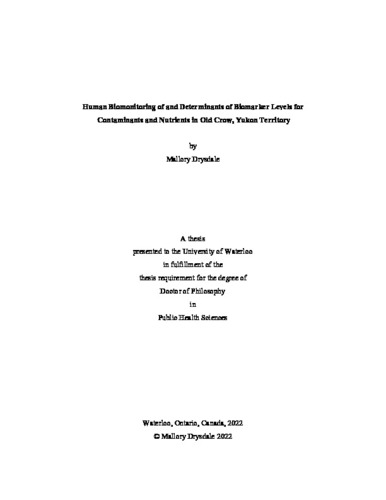| dc.description.abstract | Traditional food is an important part of the diet for many Arctic residents, particularly First Nations, and is associated with some improved health outcomes, nutrition, and food security. However, these foods can also pose potential risks via exposure to certain contaminants, including those which are found at higher levels in the Arctic. Several large-scale human biomonitoring projects have been conducted in Canada, however, prior to the one herein, none have recruited participants living in the Yukon. This thesis used the results of a human biomonitoring clinic conducted in Old Crow, Yukon, in 2019 to respond to community questions and concerns regarding human exposure levels of contaminants and nutrients in the community, and how these levels relate to traditional food consumption and other lifestyle and demographic determinants. The clinic included the collection of hair, blood, and urine samples for the analysis of contaminants and nutrients, and the administration of dietary and health messaging surveys. This thesis compared results of the clinic those from reference populations and health-based guidance values. Levels of most measured contaminants and nutrients, including most metals (e.g. mercury, cadmium), and persistent organic pollutants (POPs) (e.g. polychlorinated biphenyls (PCBs) and dichlorodiphenyltrichloroethane (DDT)) were similar in Old Crow to those in the general Canadian population and were below available health-based guidance values. Some contaminants and nutrients, including the metal nutrients manganese and cobalt, the toxic metal lead, and the pesticide hexachlorobenzene (HCB), were elevated in Old Crow relative to the general Canadian population. These contaminants and nutrients were analyzed further to identify potential local determinants of urine and blood levels. Generalized linear models were run to identify significant associations between blood and urine levels of these substances, with factors including demographics, lifestyle risk factors, and traditional food consumption. Old Crow participants had higher levels of some key contaminants and nutrients if they reported eating some traditional foods, including moose bones in soup or stew (86% higher urinary average manganese levels), caribou kidneys (22% higher average blood manganese levels and 58% higher average blood lead levels), and whitefish (28% higher average blood cobalt levels). Associations between moose and caribou organ consumption and levels of lead and HCB were also observed in reference populations in the Dehcho and Sahtú regions of the Northwest Territories, and a pooled population including those regions and Old Crow. However, no individual determinants were associated with HCB plasma levels Old Crow. In an effort to estimate dietary exposure to HCB in the community of Old Crow, a stochastic model was constructed based on dietary surveys and traditional food sampling conducted in the region. This model also estimated intake of healthy omega-3 fatty acids, including eicosapentaenoic acid (EPA) and docosahexaenoic acid (DHA) from the same foods. Modeling showed that the majority (>60%) of estimated dietary HCB intake in Old Crow was from lipid-rich caribou organs, such as fat, bone marrow, ribs, and kidney. Estimated dietary intake of HCB was below relevant health-based guidance values for all participants. Traditional foods, particularly fish, were also identified as a significant source of healthy omega-3 fatty acids. The results of this thesis support the conclusion that the benefits of traditional food consumption generally outweigh the risks of contaminant exposure for this population. | en |

